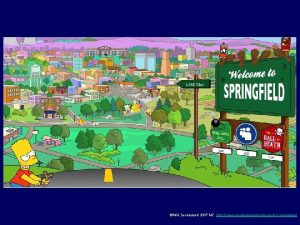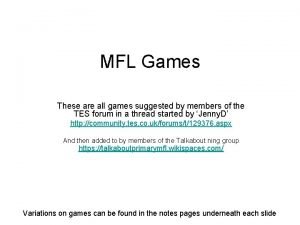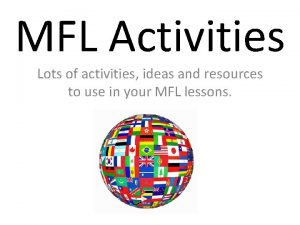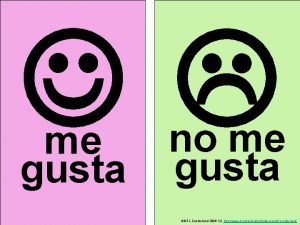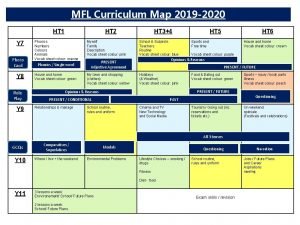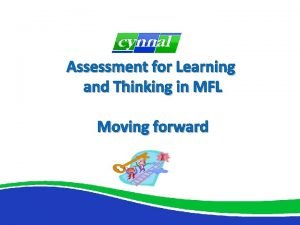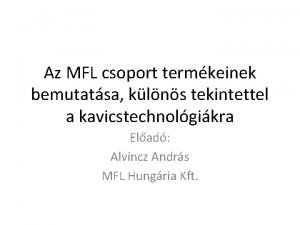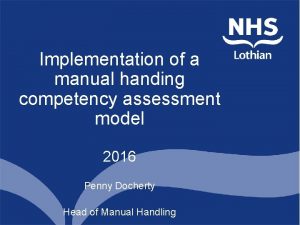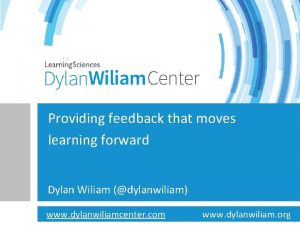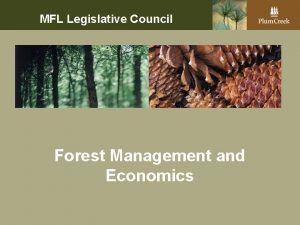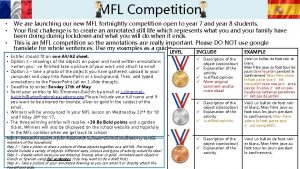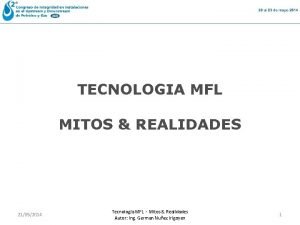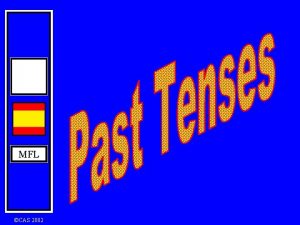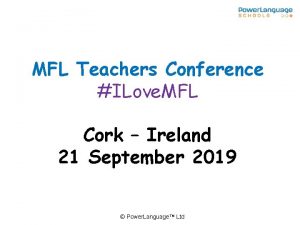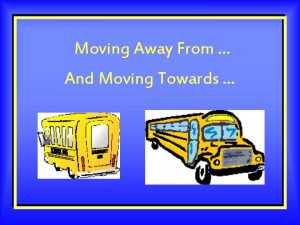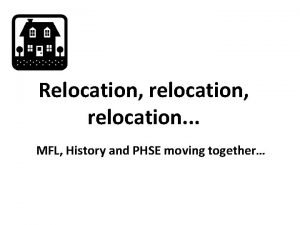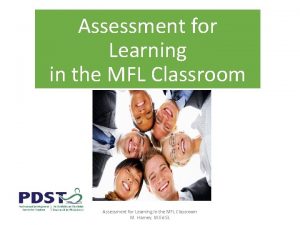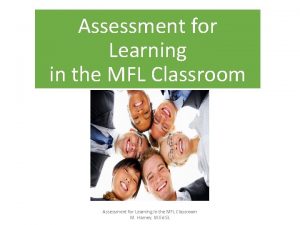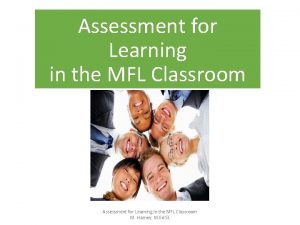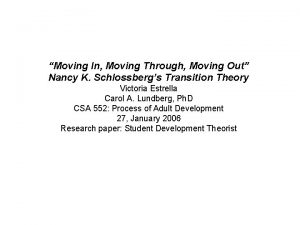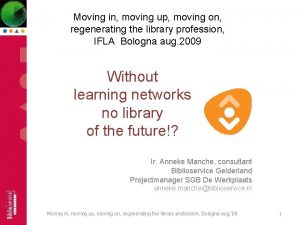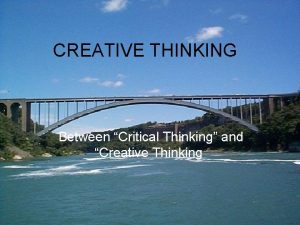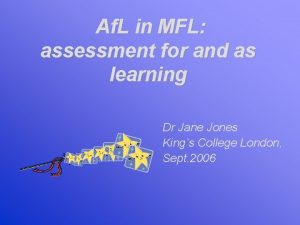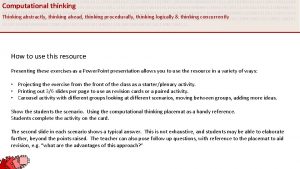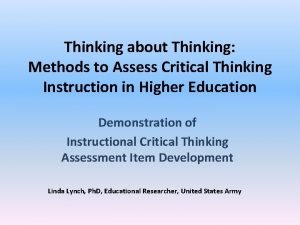Assessment for Learning and Thinking in MFL Moving



























































- Slides: 59

Assessment for Learning and Thinking in MFL Moving forward

KWLH Grid K Note what you think you already KNOW W Note what you WANT to know / learn L Once work / topic finished , return to this grid to note what you have LEARNED ( what know now). Compare with the first 2 columns. H Note down / discuss HOW you have learned ( which strategies you used)

Assessment for Learning : Key features Group activity: cards 1. Any cards that do not reflect Af. L ? 2. Which cards refer to teaching ( the teacher’s role) ? 3. Use cards to show link between teaching and learning

Reflecting on own practice How far have we embedded Af. L in our teaching and learning? Traffic light activity (individually) Grid : Key Question 2. (2. 2. 2: Af. L) Key Question 1. (1. 1. 3: Progess)

Where would you get evidence for these features? Activity : Cards Ø in pairs, match features of Af. L with possible evidence

Characteristics of lessons that develop thinking and Af. L

The role of the teacher

The role of the pupil


1. Learning intentions /objectives v Success criteria

Reflect. . . What is the difference between. . . A LEARNING INTENTION and SUCCESS CRITERIA?

Why are Learning Intentions and Success Criteria important? ‘In order for learners to take more control of their learning, they need to know what they are going to learn, why they are learning it, how they will know that they have succeeded, and why they should learn it in the first place. ’ - (An Intro to Af. L, Learning Unlimited, 2004) Learning Intentions ‘What’ and ‘Why’ Success Criteria ‘What is success’ © PMB 2007

What are Learning Intentions? ‘Learning intentions describe what the learners should know, understand, or be able to do by the end of the lesson or sequence of lessons. ’ (Learning Unlimited, 2004) Learning intentions • Note what will be learnt next • Focus on the skills that are transferable © PMB 2007

What are Success Criteria? ‘… success criteria summarise the key steps or ingredients learners need to achieve the learning intention – the main things to do, include or focus on. ’ - Shirley Clarke © PMB 2007

• “Knowing the learning intention is like knowing the rules of a game, but having the success criteria is knowing how to win. ”

WALT : what I am learning today WILF : what I am looking for

Essential Thinking principles for success criteria:

Effective Success Criteria are … • linked to the learning intentions; • specific to activities/tasks; • are discussed and agreed with learners before they undertake the activity; • give learners a focus and support whilst they undertake the activity; • are used as a basis for feedback and self-/peerassessment. © PMB 2007

Effective Success Criteria WALT : We are learning to: - write a text to persuade and inform. - identify success criteria Activity: Write an advert to attract tourists in your area I will have succeeded if: I will have succeeded if I have: • I have given information on what there is of • I have written a good interest in my area for different types of advert visitors • People enjoy reading my • I have organised my ideas into paragraphs advert. • I have used titles and subtitles • I have produced an • I have used positive adjectives attractive advert • I have used adverbs to really sell my area • I have used verbs in the imperative • I have produced some extended sentences © PMB 2007

Modelling Use examples of work : to generate success criteria to clarify understanding to discuss quality using two pieces to model success & improvement

Success criteria: examples in MFL • • Writing an advert for tourists Oral presentation on your area MFL and ICT : Photostory MFL and ICT : comic life

2. Effective Questioning

Effective Questioning Good questions that challenge the learner form an integral part of the learning process and are at the heart of good formative practice.

What is the purpose of questioning in the classroom?

The Importance of Questioning To engage and challenge learners To stimulate thinking To find out what learners know and understand already To diagnose misunderstandings and difficulties To stimulate recall and existing knowledge as a starting point for creating new meaning and understanding To support learners in extending their thinking and responses To ask learners to explain, give opinions or reasons To lead learners in constructing their own learning

Category Purpose Examples Classroom management To do with running the lesson Have you got a ruler and pencil? Lower level questions (closed) To check on understanding and recall Do we need an apostrophe here? Higher order questions (open) To develop understanding and extend thinking Is this an effective piece of writing and why?

Effective Questioning “The language classroom need to be question rich , from both teachers and learners, as part of an ongoing pedagogical dialogue to move learning forward” Dr Jane Jones Head of Teacher Education , King’s college, London

Open vs closed Closed questions can be useful however are not great at facilitating the use of abstract thinking skills, encouraging talking or eliciting much understanding. Open questions are more likely to do this and thus improve learning. e. g. Did you go out last night? What did you after school yesterday?

Higherorder Thinking Lowerorder Thinking

Effective Questioning Task : Ø In pairs , look at questions 1 – 12 Ø Match them to Bloom’s question types

Bloom’s Toolkit • • • Questions for Learning Effective stems for questioning Bloom questions for quality Thinking 30 questions Bloom’s building blocks : ex of MFL activities.

Estyn A strategy and guidance for inspecting literacy for pupils aged 3 to 18 years • Teaching - How well does the teaching. . . ? • use probing questions to improve learners’ understanding? • help learners to elaborate on their answers and make learning connections?

Activities in MFL and Bloom Taxonomy Task : Cards ØWork in pairs Ø Decide which level of thinking (Bloom’s taxonomy) each task relates to.

What strategies can I use to get better responses?

What strategies can I use to get better responses? • Will changing my approach to questioning improve the quality of answers? • Does the type of questions I ask improve learners’ motivation? • extending wait time, think-pair-share • using incorrect answers instead of ignoring them • planning questions before the lessons

Wait time • Essential Øto enable learners to think about responses Ø to develop Thinking skills. • Strategies to use: Ø No hands- up Ø Think Pair Share Ø Talking partners Ø Mini white boards

Questioning and Metacognition

what? What is metacognition? Why? How? When? Who?

Possibly Always Never Why develop thinking skills and assessment for learning in the classroom? Categorise the questions according to how likely they are to encourage and develop metacognition! Remember, you will be asked to justify any decisions made… You may wish to consider improvements to questions to help them move category! ACCAC

What do I have to do? How do I know? Making sense of the task What could I use here? Why did I use it before? Knowledge and Why develop thinking skills and Making understanding connections of strategies assessment for learning in the and methods Metacognition classroom? Where have I used this How did I get here? What do I need next? before? How do I know? Monitoring and evaluating learning SMT pack 2009 Knowledge and understanding of thinking process and principles What worked well? ACCAC How will it next help?

May be Always Never When will you do this again? How will you carry out an internet search? Why do you like this book? Where have you used diamond ranking before? Is the source biased? How do What is photosynthesis? you know? What did you find difficult about the activity? How is this similar to your earlier design? Why will you carry out an internet search? Should this improve your answer? What do you think about this poem Where did you get that idea from? Can you tell me about your story? Is there another way to do this? What do you like about the picture you have drawn?

Work as a pair with your talk partner. Look carefully at the words you have been given • Which words do you think belong together? • Why do you think these words belong together? • How are you deciding which words are linked? • What do you think the linked words mean? • How do you know this?

3. Self or peer- assessment


Peer/ self assessment using success criteria • ICT : Ø Photo story Ø Comic life • Oral presentation • Written task

4. Effective feedback

Discuss ! well done ! Good effort! well written and a lot of good points! Underline the date and the title!

Constructive feedback Feedback needs to • allow learners to know what is going on in their learning. • be useful so that they can help the learner to move on. • be qualitative • refer to skills

Estyn A strategy and guidance for inspecting literacy for pupils aged 3 to 18 years Marking and assessment • Is marking up-to-date? • Are there are many gaps in pupils’ books, or missing work? Does the teacher notice this? • Is there a common marking policy within and between subjects, not just in grading but with regard to correcting spelling, improving presentation etc? • Are comments on pupils’ books diagnostic and do they show pupils how to improve? • Do pupils follow up teachers’ comments eg to redraft, correct or complete work? • Is there self or peer marking and self or peer assessment? • Are ‘toolkits’ and marking matrices for

Examples • Rugby ! • Errors used to improve / consolidate learning.

Targets for improving writing Task: In pairs, look at the handout: Ø ADVICE FOR IMPROVEMENT – TARGETS (Newbridge comprehensive school – MFL dept) Discuss the following questions: • • Are these targets useful? Do they help learners move forward? Are they constructive? Could you add some targets ?

Task WALT: Learning objective: To plan a learning sequence where Af. L and thinking are embedded in the teaching and learning. No need to create activities. DISCUSS and PLAN only! WILF: Ø Ø Ø Work in pairs Select a specific year group / class Agree on a written task (type of writing/purpose/ audience) Plan a sequence of activities prior to learners producing the written task Use the resources provided : How to develop Af. L and Thinking toolkit, Gris Af. L and suggested tools , laminated handout , Bloom toolkit, peer/ self- assessment examples, ideas from the presentation ( ICT, etc) Success criteria: You need to include: Ø learning intentions/ objectives Ø Ways to identify the success criteria ( use of modelling/ pairs/ teacher/? ) Ø Decide on type of assessment: peer/ self/ teacher Ø Plan ways to feedback in a constructive manner Ø Use at least 3 different TOOLS from the toolkit

Next steps ?

Estyn Features of Excellence: Teaching This year, as in previous years, the features of outstanding teaching included: ✓ careful and considered preparation and planning that involved pupils; ✓ the use of innovative approaches to planning and delivering learning; ✓ the promotion of active learning through challenge and the use of motivating stimuli; and ✓ the use of searching open questions to encourage in-depth responses to develop confident communication skills.

Features: Teaching Teacher as ‘facilitator’: • • • Supportive and stimulating learning environment Clear lesson objective(s) Questions/activities that link back to prior learning/experiences Purposeful planning to develop skill/skills and/or knowledge and understanding Appropriate use of assessment for learning strategies Learner-focused activities that are appropriate and challenging for the range of ability. Every learner being included Opportunities for learners to take part in paired or group activities and to discuss their ideas Effective teacher questioning, open and sequenced to develop learning. Allowing thinking time Frequent teacher feedback that moves the learning on.

Features: Learning • • • Enthusiastic response from learners – they are fully engaged in the lesson. Recall and building on prior learning and skills. Learners determining success criteria. Learners demonstrate development of specific skill/skills, knowledge and/or understanding. Learners explaining their responses. Learners engaging in self and/or peer assessment. Learners reflecting on what they have learnt. Awareness of which learning strategies they have used, why they have used them and how effective they were. Learners connecting their learning to other aspects of their subject, other subjects and everyday situations. The link between the teaching and learning leads to collaborative/independent learners.

Learning Journey START • Clear aims including reference to skills • Stimulus • Questions/activities relating back to prior learning/experience Questioning Engagement Learner centered Activities Whole class – group - pair Varied learning strategies Appropriate ‘Pace’ Challenge Enjoyment High Expectations END Ensure sufficient time for learners to demonstrate: • what they have learnt • awareness of which learning strategies they have used • an understanding of how effective their learning was. Reflect on the learning aim(s)/success criteria. Discuss the next step in their learning.


KWLH Grid K W Note what you think you already KNOW Note what you WANT to know / learn √ √ L Once work / topic finished , return to this grid to note what you have LEARNED ( what know now). Compare with the first 2 columns. H Note down / discuss HOW you have learned ( which strategies you used)
 Glatzhaarig
Glatzhaarig Atantot extra
Atantot extra Mfl activities
Mfl activities Mfl sunderland
Mfl sunderland Sunderland mfl
Sunderland mfl Mfl curriculum map
Mfl curriculum map Questioning in mfl
Questioning in mfl Sunderland mfl
Sunderland mfl Mfl austria
Mfl austria Manual handling competency assessment form
Manual handling competency assessment form Cuadro comparativo de e-learning b-learning y m-learning
Cuadro comparativo de e-learning b-learning y m-learning Positive thinking vs negative thinking examples
Positive thinking vs negative thinking examples Thinking about your own thinking
Thinking about your own thinking Holistic thinking example
Holistic thinking example Perbedaan critical thinking dan creative thinking
Perbedaan critical thinking dan creative thinking Thinking about you thinking about me
Thinking about you thinking about me Dylan williams feedback
Dylan williams feedback Fspos vägledning för kontinuitetshantering
Fspos vägledning för kontinuitetshantering Typiska drag för en novell
Typiska drag för en novell Nationell inriktning för artificiell intelligens
Nationell inriktning för artificiell intelligens Ekologiskt fotavtryck
Ekologiskt fotavtryck Varför kallas perioden 1918-1939 för mellankrigstiden?
Varför kallas perioden 1918-1939 för mellankrigstiden? En lathund för arbete med kontinuitetshantering
En lathund för arbete med kontinuitetshantering Kassaregister ideell förening
Kassaregister ideell förening Vilotidsbok
Vilotidsbok Sura för anatom
Sura för anatom Förklara densitet för barn
Förklara densitet för barn Datorkunskap för nybörjare
Datorkunskap för nybörjare Tack för att ni lyssnade bild
Tack för att ni lyssnade bild Mall debattartikel
Mall debattartikel Magnetsjukhus
Magnetsjukhus Nyckelkompetenser för livslångt lärande
Nyckelkompetenser för livslångt lärande Påbyggnader för flakfordon
Påbyggnader för flakfordon Arkimedes princip formel
Arkimedes princip formel Publik sektor
Publik sektor Jag har nigit för nymånens skära
Jag har nigit för nymånens skära Presentera för publik crossboss
Presentera för publik crossboss Teckenspråk minoritetsspråk argument
Teckenspråk minoritetsspråk argument Plats för toran ark
Plats för toran ark Treserva lathund
Treserva lathund Luftstrupen för medicinare
Luftstrupen för medicinare Claes martinsson
Claes martinsson Cks
Cks Byggprocessen steg för steg
Byggprocessen steg för steg Mat för idrottare
Mat för idrottare Verktyg för automatisering av utbetalningar
Verktyg för automatisering av utbetalningar Rutin för avvikelsehantering
Rutin för avvikelsehantering Smärtskolan kunskap för livet
Smärtskolan kunskap för livet Ministerstyre för och nackdelar
Ministerstyre för och nackdelar Tack för att ni har lyssnat
Tack för att ni har lyssnat Mall för referat
Mall för referat Redogör för vad psykologi är
Redogör för vad psykologi är Borstål, egenskaper
Borstål, egenskaper Tack för att ni har lyssnat
Tack för att ni har lyssnat Borra hål för knoppar
Borra hål för knoppar Orubbliga rättigheter
Orubbliga rättigheter Variansen formel
Variansen formel Tack för att ni har lyssnat
Tack för att ni har lyssnat Rita perspektiv
Rita perspektiv Vad är verksamhetsanalys
Vad är verksamhetsanalys
